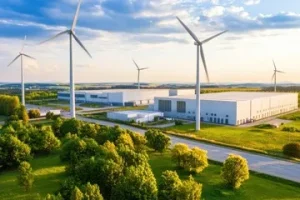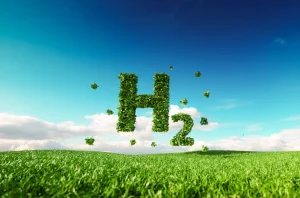PEM Electrolyser: The Future of Clean Hydrogen Production
What is an Electrolyser?
An electrolyser is a device that uses electrical energy to split water (H2O) into hydrogen and oxygen through a process called electrolysis. This technology forms the foundation of clean hydrogen production, especially when powered by renewable electricity sources like solar and wind. The resulting hydrogen gas can be stored, transported, or used immediately as an energy carrier, while the oxygen is often vented or repurposed for industrial processes.
What is a PEM Electrolyser?
A PEM (Proton Exchange Membrane) electrolyser is a specific type of electrolyser that uses a solid polymer electrolyte to facilitate the electrolysis process. Unlike alkaline electrolysers, PEM systems offer higher efficiency, faster response times, and more compact designs. These features make them ideal for dynamic operations, such as coupling with intermittent renewable energy sources.
In a PEM electrolyser, water is fed into the anode side. When electricity is applied, it splits into protons (H+), electrons, and oxygen. The protons pass through the membrane to the cathode side, where they recombine with electrons to form hydrogen gas. The oxygen is released as a by-product.
Key Features of PEM Electrolysers
- Solid Polymer Membrane: Acts as both electrolyte and separator
- Compact and Lightweight: Ideal for space-constrained applications
- Quick Response: Adjusts rapidly to changes in power input
- High Purity Hydrogen: Delivers 99.99% pure hydrogen
- High Current Density: Allows for smaller systems with more output
Cost and Scalability of PEM Electrolysers
While PEM electrolysers are currently more expensive than traditional alkaline systems, ongoing advancements in materials and manufacturing are steadily reducing costs. As global demand for green hydrogen grows, economies of scale and increased production capacity are expected to make PEM technology more affordable and accessible. Governments are also providing subsidies and incentives to promote clean hydrogen infrastructure, helping businesses adopt PEM electrolysers as a long-term investment in sustainable energy. Understanding the total cost of ownership—including installation, maintenance, and energy input—can help organizations make informed decisions about integrating PEM systems into their operations.
Why Choose PEM Electrolysers for Green Hydrogen Projects
PEM electrolysers are the preferred choice for green hydrogen production due to their superior efficiency and ability to work seamlessly with renewable energy sources like solar and wind. Their fast ramp-up capabilities make them ideal for balancing intermittent energy supply, ensuring continuous hydrogen generation even with fluctuating power inputs. Whether you’re developing a hydrogen refueling station or a large-scale renewable energy project, PEM electrolysers provide the flexibility, purity, and performance required to meet clean energy targets. By investing in PEM technology today, industries can future-proof their operations and lead the transition to a zero-emission hydrogen economy.
Where Are PEM Electrolysers Used?
PEM electrolysers are suitable for a variety of applications due to their scalability and responsiveness:
- Industrial Hydrogen Production:
- Steel manufacturing
- Fertilizer and ammonia production
- Chemical synthesis
- Transportation:
- Fueling hydrogen fuel cell electric vehicles (FCEVs)
- Aviation and shipping industries
- Renewable Energy Integration:
- Converts surplus solar/wind energy into storable hydrogen
- Supports grid stability and energy storage
- Backup Power Systems:
- Emergency power for hospitals, data centers, and telecoms
- Residential and Commercial Use:
- Combined heat and power (CHP) systems
- On-site energy storage
Benefits of PEM Electrolysers
- Zero Emissions: When powered by renewables, produce only hydrogen and oxygen
- Flexible Operation: Can start and stop quickly, perfect for variable energy sources
- High Efficiency: 70–80% efficiency, higher than traditional methods
- Modular Design: Easily scalable from kilowatts to megawatts
- Durable and Safe: Designed for long operational lifespans and minimal risk
Challenges and Limitations
- High Capital Cost: More expensive than alkaline electrolysers
- Membrane Durability: Sensitive to impurities and requires clean water
- Complex System Requirements: Needs cooling, water purification, and careful operation
Frequently Asked Questions
1. How does a PEM electrolyser differ from an alkaline electrolyser?
PEM uses a solid polymer membrane and offers faster response, compact size, and higher purity hydrogen, whereas alkaline systems use a liquid electrolyte and are cheaper but slower.
2. What kind of water does a PEM electrolyser need?
It typically requires deionized or distilled water to prevent membrane degradation.
3. Is a PEM electrolyser suitable for home use?
Currently, they are better suited for industrial or commercial use due to cost and complexity, but home-scale versions are in development.
The Role of PEM Electrolysers in the Hydrogen Economy
PEM electrolysers are at the forefront of the green hydrogen movement. Their compatibility with renewable energy, high efficiency, and ability to generate clean hydrogen on-demand make them critical for meeting climate goals. Governments and industries are investing heavily in PEM technology to decarbonize sectors like transportation, energy, and manufacturing.
From a technical and strategic standpoint, PEM electrolysers offer a powerful solution for energy storage, grid balancing, and clean fuel production—all essential elements of a sustainable energy future.
Are you exploring hydrogen solutions for your project or business? Get in touch with our team to learn how PEM electrolysers can power your future.





